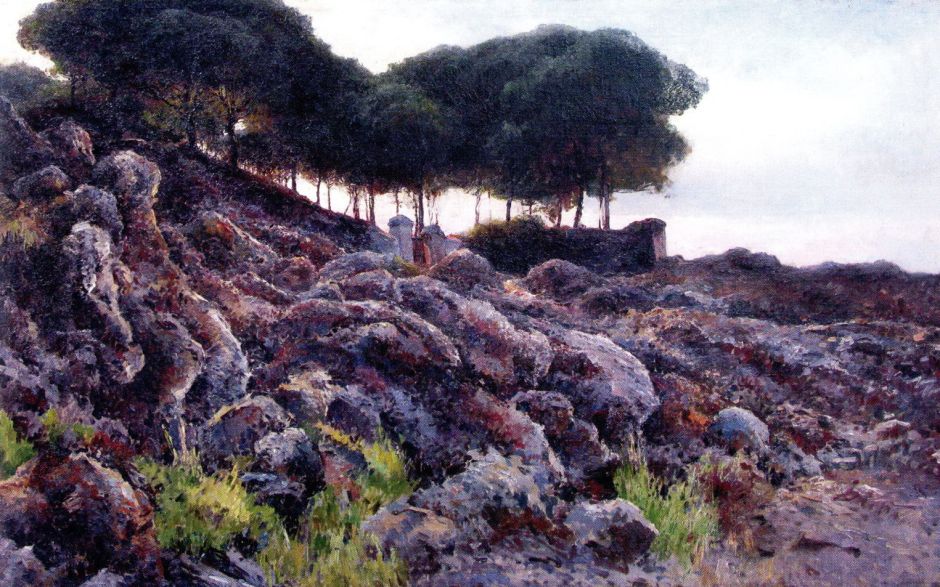Another pupil of Volodymyr Orlovsky when he was teaching at the Imperial Academy in Saint Petersburg was the young Mykhaylo Berkos (1861–1919) from Odesa, Ukraine.
Berkos’ father was Greek, but the family lived in Odesa, and it was there that he first studied art, at the city’s Drawing School. He moved to Saint Petersburg to study at the Imperial Academy of Arts there in 1878, where Orlovsky was one of his teachers. He completed that training in 1889, when he had won a succession of medals including the gold. This secured him funds to travel in Europe, and over the next three years he visited France, Germany, Spain, Italy and Switzerland.

In 1891, he was in central France, where he painted this Landscape in Auvergne, France. In this period, he became an enthusiastic plein air painter, and was influenced by Impressionism, although his paintings retain considerable detail, as shown here in the wild plants in the foreground.

I’m not sure where he painted these Flax Blooms in 1893; they’re a particularly appropriate theme for an accomplished oil painter, as flax is the source of linseed oil, one of the major drying oils used as a binder in many oil paints.
In the mid-1890s he settled down to live and paint just to the north of the city of Kharkiv, in north-eastern Ukraine.

His Bog. Blagodatne Village from 1895 shows the wetlands near a small village perhaps close to Kharkiv. Although his lily pads are painterly, they remain more distinct and detailed than those of Claude Monet, for example.

This atmospheric painting of a Street in Uman from 1895 shows the dusty semi-rural road in what has since become a city of over 80,000 in central Ukraine. During its German occupation in the Second World War, over 17,000 Jews were massacred here. It has subsequently become a site of major international Jewish pilgrimage, and home to the Uman National University of Horticulture.

Blossoming Garden with Poppies from 1896 shows a thatched cottage with flowers that appear to be a ‘pom-pom’ variety of poppy in the foreground.

Thistles (1898) is another study of wild flowers, probably painted in the countryside not far from Kharkiv.
In 1899, Berkos visited Italy again.

He painted this view of a garden on the island of Capri (1899).

In this painting of Sorrento from the same year, Berkos shows trees growing in an old ruined building facing the Bay of Naples, on the peninsula closest to Capri.

I’ve been unable to locate this painting of Iskriya Island, also from 1899, although it could be the Island of Isca, on the south coast of that peninsula.

On the Farm. Mala Danylivka from 1903 shows the village just north of Kharkiv where Berkos settled with his wife, and possibly their small farmstead. This has become a suburb, not far from the city’s ring road.

In 1903, Berkos visited Italy again, this time its northern city of Venice, where he painted this watercolour view of boats On a Canal Near Venice (1903). Although few examples appear to have survived, he was an accomplished and prolific painter in watercolours as well as oils.
In 1904, Berkos started teaching at the school of drawing in Kharkiv, and eight years later was a prime mover and teacher in the Kharkiv Art College. He exhibited extensively in Paris, Ukraine and Russia.

He completed this classic Impressionist motif of an Apple Tree in Blossom in 1919.
Just before Christmas 1919, Berkos died of typhus in Kharkiv, at the age of only 58. The deadly disease had been introduced during a major offensive of the Russian Civil War, and killed many of the White Guard retreating from their defeat, as well as local civilians. Most of the paintings in his studio at that time were burned by his wife. Fortunately by that time many had made their way into public and private collections, both within Ukraine and beyond.
References
Andrey Kurkov and others (2022) Treasures of Ukraine, A Nation’s Cultural Heritage, Thames & Hudson. ISBN 978 0 500 02603 8.
Konstantin Akinsha and others (2022) In the Eye of the Storm, Modernism in Ukraine 1900-1930s, Thames & Hudson. ISBN 978 0 500 29715 5.

